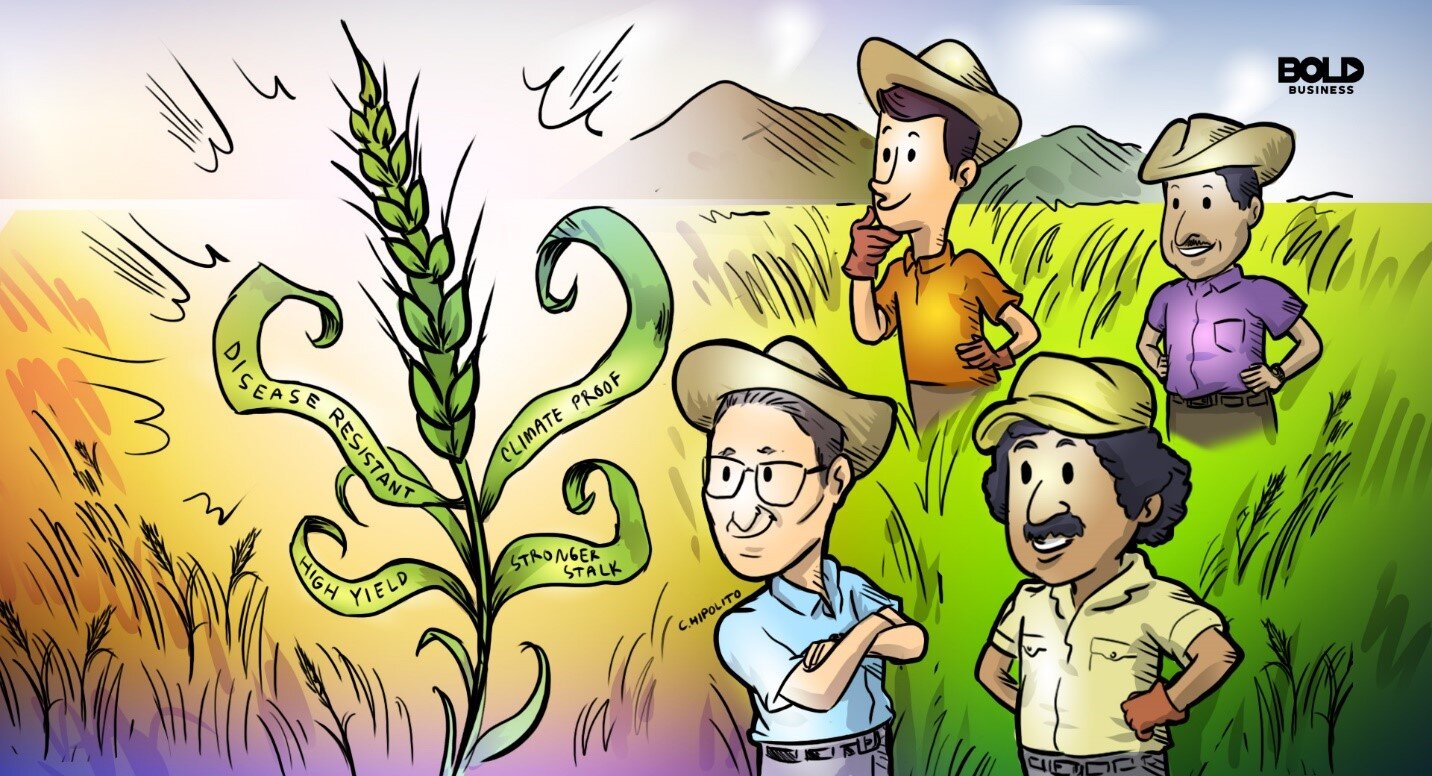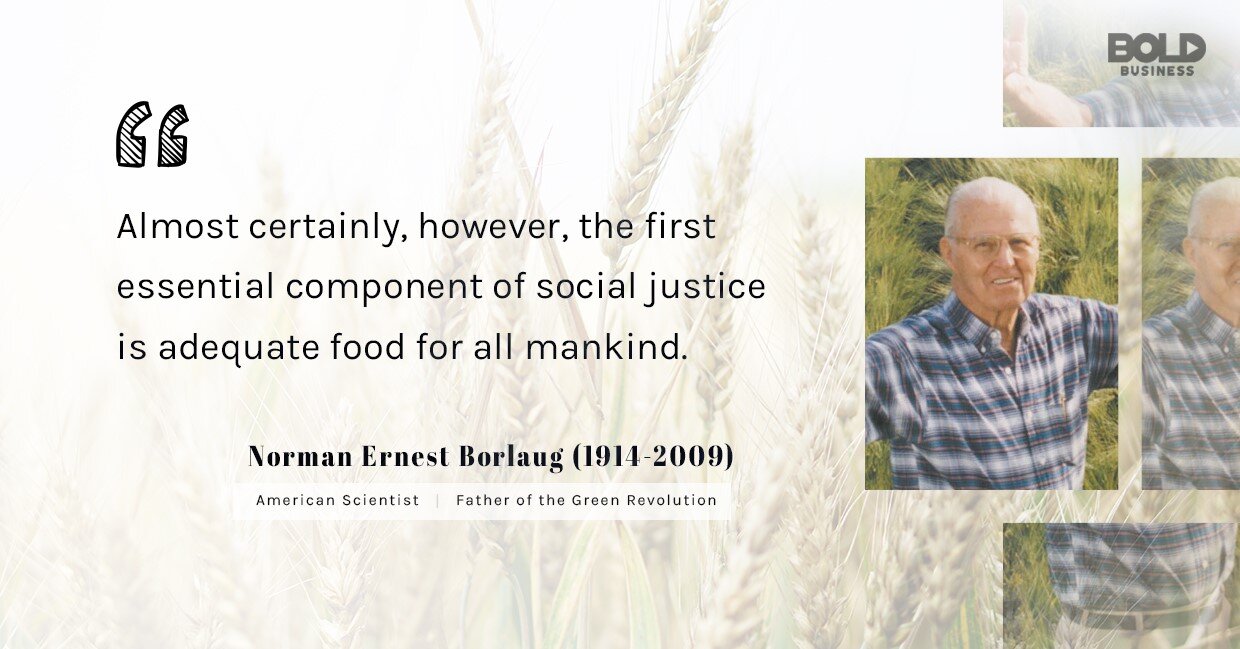Norman Ernest Borlaug (/ˈbɔːrlɔːɡ/; March 25, 1914 – September 12, 2009) was an American agronomist who led initiatives worldwide that contributed to the extensive increases in agricultural production termed the Green Revolution.
Roderic Buller (right), a Rockefeller Foundation agronomist, was one of four Foundation staffers positioned as a soil scientist assisting Norman Borlaug in Mexico in 1956, revolutionizing this region into "one of the largest and most powerful associations of livestock producers in the Mexico," the Livestock Union of Chihuahua.
Norman Borlaug may not be a household name, but he should be. After all, he saved a billion people from starvation. He helped entire nations recover from the debilitating shackles of hunger through his work in crop production and plant breeding. But most notable of all was his attempts to shift the conversation towards eradicating widespread starvation. A true citizen of the planet, he lived a life determined to end world hunger.
For all his efforts, Borlaug is one of the few people to receive the 1970 Nobel Peace Prize, the Presidential Medal of Freedom, and the Congressional Gold Medal. Daring, steadfast and tireless—Borlaug’s efforts to improve crop yield and end world hunger were seeds of hope that inspired people in generations to come.
“the man who has saved more lives than any other person who has ever lived”, Norman Borlaug, the founder of the World Food Prize and “Father of the Green Revolution”.
A true citizen of the planet, Norman Borlaug lived a life determined to end world hunger!
A Life of Purpose: The Early Years of Norman Borlaug
Born on March 25, 1914, Norman Ernest Borlaug was a descendant of Norwegian immigrants who moved to Wisconsin around the 1850s. His great grandparents acquired a farm near Cresco, Iowa where the family settled down. Borlaug was the eldest of four children to parents Henry Oliver and Clara. He attended a one-room rural school in Howard County. Eventually, through his grandfather’s prodding, the 19-year-old Borlaug decided to leave the farm and pursue higher education. He was accepted at the University of Minnesota’s 2-year general college program. Later on, he moved to the College of Agriculture’s Forestry Program. He completed his bachelor’s degree in Forestry in 1937, his master’s degree in 1940, and his doctorate in Plant Pathology and Genetics in 1942. But he learned the most profound lessons in life while working in the Civilian Conservation Corps.
The plight of the poor deeply moved Norman Borlaug to the action!
The plight of the poor deeply moved Borlaug. He was convinced that hunger doesn’t just hurt the stomach—it also injures the mind and robs people of dignity. The realization that something needed to be done dawned on him.
Norman Borlaug and the Green Revolution
After completing his education, Borlaug joined DuPont in 1942 as a microbiologist researching on industrial-grade agricultural products. In 1944, his stay in the industry was cut short when he joined the newly established Cooperative Wheat Research and Production Program by the Rockefeller Foundation. At the time, Mexico was plagued by a stem rust fungus that had been destroying the crops. Impoverished farmers were struggling with low crop yield, and Mexico was dependent on imports for grains. Along with two other crop breeders and a soil scientist, Borlaug began the relentless search for ways to improve wheat production in Mexico. Using the shuttle method—a method that Borlaug invented—the team worked on producing disease-resistant varieties of wheat that could thrive in harsh climates. His plant-breeding methods also introduced a semi-dwarf wheat variety with stronger stalks. The result was Norin 10/Brevor 14, a disease-resistant, high-yield, semi-dwarf strain that increased Mexico’s harvest by six-fold. By 1963, Mexico was self-sufficient in wheat production and a grain exporter to other countries.
Because of Norman Borlaug’s bold action to help impoverished farmers, Mexico became self-sufficient in wheat production and a grain exporter to other countries by 1963!
The Green Revolution Reaches Asia
Borlaug’s disease-resistant, high-yield and short-stemmed wheat varieties were sent to various agricultural institutes across the globe. A few of Borlaug’s wheat varieties made it to the Indian Agricultural Research Institute in Pusa, New Delhi, India. In the mid-1960s, the Indian subcontinent was suffering from the aftermath of war. India and Pakistan were experiencing food shortages. With the cooperation of local agricultural scientists and researchers, Borlaug and the Green Revolution expanded in Asia. By 1970, India’s wheat production increased to 20.1 million tons from 12.3 million tons. Pakistan was able to double a yield from 4.6 million tons in 1965 to 7.3 million tons in 1970.
It is without a doubt that Norman Borlaug and the Green Revolution truly impacted countless lives.
The Bold Leadership of Norman Borlaug
• Brave, Tenacious and Tireless
Borlaug and the Green Revolution touched countless lives. However, it was an endeavor rife with challenges and obstacles. When he first arrived in Mexico, his efforts were not greeted with enthusiasm. The farmers were suspicious and hostile toward the program. Also, equipment, tools, and proper training were lacking. Nevertheless, Borlaug pressed on and single-handedly achieved the goal at a record-breaking pace. In Asia, bureaucracy, economic barriers, and cultural opposition hindered the immediate implementation of his programs. Still, this did not stop Borlaug from achieving his goal.
• Resourceful and Creative
Disease-resistant wheat varieties were first grown with long and thin stalks. As the wheat matured and ripened, the stems were unable to support the weight of the grain. Due to this lodging trait of the strain, Borlaug thought of creating a variety with the stronger and shorter stalk by crossbreeding it with Norin 10—a Japanese dwarf wheat variety. The result was a high-yield and stronger semi-dwarf breed.
• Commitment, Purpose, and Compassion
Borlaug has always believed that “Food is the moral right of all who are born into this world.” Without a doubt, this belief propelled the Nobel Peace Prize Awardee to continue to find ways to increase food yield. His participation in agricultural research and food activism only intensified through the years. He founded the World Food Prize, which recognizes individuals who helped improve the world food supply. Indeed, Borlaug’s commitment, purpose, and passion were unwavering until his last days in 2009.
Borlaug’s legacy will surely continue to make an impact in the lives of generations to come.
A Legacy That Will Never Be Forgotten
On March 25, 2014, a statue was unveiled in the National Statuary Hall alongside the country’s greatest heroes to commemorate Borlaug’s centennial celebration. In various parts of the world, from Mexico to India to Bolivia, Borlaug’s contribution to improving food production was—and always will be—remembered over the years. Undeniably, Norman Borlaug’s life, work, and achievements have and will continue to inspire people to help the poor and the hungry.









